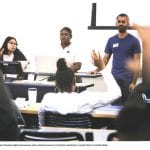The month’s highlights on higher education from across the web
1.My university forced me into teaching training It was all dry ‘eduspeak’

This month an anonymous academic writes to The Guardian to complain about their experience of mandatory teacher training. Highlighting ‘dry lectures’, a preponderance of ‘eduspeak’ and a lack of relevance between the course and their realities of the lecture or tutorial classroom, this article (and the comments beneath it) show an understandable collective frustration with the way higher-ed teaching programs are run. Some criticisms appear as low-hanging fruit – complaints about eduspeak, for example, have long been levelled at education research, despite all disciplines having their own sets of rules, methods and terms. This criticism aside, the article does touch on the question as to whether teaching training ought to be mandatory in higher education and, if it were, what form it needs to take to make it more meaningful. This is a good read for those in academic development and a call for those who teach such programs to sit up, listen, and practice what they preach.
2. How professors view students: the most satisfying and challenging part of the job

Reporting from a survey of nearly 1,000 faculty members, this short article from The Chronicle does exactly what it says on the tin and tells us how academic staff view their students. While the headline gives away the main findings, some of the differences within the population are still worth a read. For example, casual or adjunct faculty staff were both more satisfied and more challenged by teaching than their tenure track colleagues, while Business academics report a greatest perceived strain in working with today’s students compared to those of former years. Even if the data are reflective of a US setup, the interactive graphs and features offer a nice insight into the ways we perceive teaching and our students.
3. What does student-led teaching award nomination data tell us about student perceptions of ‘good’ feedback?

Over at the UK’s QAA, the quality assurance body for UK higher-ed, comes a report focused on what students perceive to be good feedback. The document is twelve pages long but with enough gloss and image to make for a decent skim read. Broadly, the report highlights three key themes that shape students’ experience of feedback. The first, the nature of the feedback, was most significant and refers to the kinds of feedback we give to our students. For example, does the feedback explain the student’s performance, motivate or guide them to future goals? Is it fair, personalised and consistent? The second major theme was that students value the personal qualities of the teacher. For example, is that teacher welcoming and open, passionate about their subject? Is that teacher responsive to student input? Lastly, support for students was the final key theme – with students valuing academic expertise, the time dedicated to providing feedback and the teacher’s availability. The report concludes, not with recommendations, but instead with discussion points and questions that academics can use to consider how they might utilise this in their own subjects.
4. Will moving office hours online get students to show up?

As we approach the end of semester we usually see an uptick in student queries. Whether or not we maintain office hours, chances are that most of us have experienced either polarity of this form of student support, either scheduling time for student drop-ins to find that no-one attends or struggling to manage too many students face-to-face in the one time period. While email and discussion boards offer alternative ways of answering last minute questions and providing feedback, the unboundedness of contact and access can create other issues. Over on the edTech news site EdSurge we hear from Stefan Stoll, an associate professor of chemistry at the University of Washington. Stefan has had a lot of success in using online office hours to provide additional support to a large group of students over the LMS. Outlining the hows and whys of what he does, this article gives us enough tips and details for us to not only understand but replicate this approach with our own students.
5. What professors can learn about teaching from their students [Archival $]
 For academics, there is a lot we can learn from students about how we can improve our teaching. At Sydney, as elsewhere, the end of semester student surveys (the USS) are the main channel used to collect student feedback on our teaching. However, a number of recent reports have again highlighted the dangers of using this type of feedback as the primary (or only) source of student commentary. This article from The Chronicle of Higher Education shows one particularly creative way that teachers have got useful feedback from students outside of the institution’s official survey channels. At the University of California Merced, trained undergraduate student observers are being deployed into classrooms to provide detailed, structured, and meaningful feedback to teachers on their classes. Imagine something like the peer observation programs you might be familiar with, only conducted from a student’s perspective. While you might hesitate at first, you could find yourself pleasantly convinced by what is described, along with the insights and benefits that can be gained from such as student-teacher partnership. This is a good case for how formal student observations can provide practical feedback that can benefit student and teacher alike. Behind a paywall but available for free through the Usyd library.
For academics, there is a lot we can learn from students about how we can improve our teaching. At Sydney, as elsewhere, the end of semester student surveys (the USS) are the main channel used to collect student feedback on our teaching. However, a number of recent reports have again highlighted the dangers of using this type of feedback as the primary (or only) source of student commentary. This article from The Chronicle of Higher Education shows one particularly creative way that teachers have got useful feedback from students outside of the institution’s official survey channels. At the University of California Merced, trained undergraduate student observers are being deployed into classrooms to provide detailed, structured, and meaningful feedback to teachers on their classes. Imagine something like the peer observation programs you might be familiar with, only conducted from a student’s perspective. While you might hesitate at first, you could find yourself pleasantly convinced by what is described, along with the insights and benefits that can be gained from such as student-teacher partnership. This is a good case for how formal student observations can provide practical feedback that can benefit student and teacher alike. Behind a paywall but available for free through the Usyd library.
6. Font of all knowledge? Researchers develop typeface they say can boost memory
 This piece of reportage from The Guardian, has been doing the rounds across the web. A lot of the reporting on this has been marked by headlines with highly clickable silver-bullet claims to cognitive enhancement. Such hyperbole belies the more modest (though playful) research story and findings. Produced by a team at RMIT University’s Behavioural Business Lab and Design School, Sans Forgetica is a font originally designed to assist students in cramming for exams. Characterised by a backwards slant and gaps in each letter, the font is designed to allow readers’ minds to slow the reading process and work towards “filling the gaps”. Based on the notion of desirable difficulty, Sans Forgetica can be seen as a typographic embodiment of many existing theories in education and learning science. Educational theory has long emphasised the need for the student to actively do something and for us as teachers to refrain from providing all the answers. Existing concepts like the Zone of Optimal Confusion align with this idea of desirable difficulty – something any crossword, puzzle or video game lover will intuitively know all too well. While typography lecturer Stephen Banham advises against producing novels or large swathes of text in this font, this article nevertheless reminds us (whatever our choice of font) to leave gaps for our students to fill and to refrain from trying to do all the work for them. For added fun, download this font as a Chrome browser extension at: sansforgetica.rmit
This piece of reportage from The Guardian, has been doing the rounds across the web. A lot of the reporting on this has been marked by headlines with highly clickable silver-bullet claims to cognitive enhancement. Such hyperbole belies the more modest (though playful) research story and findings. Produced by a team at RMIT University’s Behavioural Business Lab and Design School, Sans Forgetica is a font originally designed to assist students in cramming for exams. Characterised by a backwards slant and gaps in each letter, the font is designed to allow readers’ minds to slow the reading process and work towards “filling the gaps”. Based on the notion of desirable difficulty, Sans Forgetica can be seen as a typographic embodiment of many existing theories in education and learning science. Educational theory has long emphasised the need for the student to actively do something and for us as teachers to refrain from providing all the answers. Existing concepts like the Zone of Optimal Confusion align with this idea of desirable difficulty – something any crossword, puzzle or video game lover will intuitively know all too well. While typography lecturer Stephen Banham advises against producing novels or large swathes of text in this font, this article nevertheless reminds us (whatever our choice of font) to leave gaps for our students to fill and to refrain from trying to do all the work for them. For added fun, download this font as a Chrome browser extension at: sansforgetica.rmit





